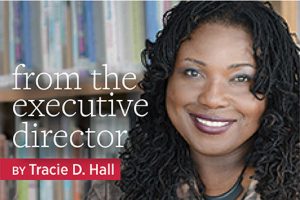
When I began the journey toward the role of ALA president in 2020, I had no idea what the future would hold for our libraries, for us as library workers, or for our Association. I did not foresee the ways many of us would work to create a more equitable world—necessary steps taken in the face of a pandemic, racial injustice, and a cultural backlash against freedom of information, among other obstacles. Now, almost three years later, I wonder how many of these changes will remain.
As we approach a new year, I challenge each of us to take the lessons we’ve learned and make these changes permanent. I challenge us to continue making programs and services more accessible for as many as possible, such as by offering livestream and hybrid options. When we center universal design, we are serving all members of our communities. And when we advocate to provide information access for all, that includes those inside and outside our buildings.
We must also value our library workers. We cannot have libraries without library workers, many of whom are stretched thin and are feeling burned out and frustrated in the face of book challenges, budget cuts, and uncertain socioeconomic landscapes. We sensed this before the pandemic, but a 2021 article from researcher and library leader Kaetrena Davis Kendrick confirmed it. In “Leaving the Low-Morale Experience: A Qualitative Study,” published in Alki, Washington Library Association’s journal, study respondents said that workplace stressors—such as understaffing, overreliance on part-time employees, and high turnover—“degraded availability or quality of library services, which were expected to continue at the same level or standard even as administrative or financial support decreased.”
And more recently, the 2022 Urban Library Trauma Study confirmed what many of us have experienced over the past few years: a repetitive cycle of outside stressors and adverse events; professional community response (or lack thereof); and internalization, or self-blame, for traumatic experiences. These factors—on top of continually strained budgets, budget cuts, and low pay across the library sector—contribute to workplace trauma.
The path forward is investment: economic and moral investment in accessibility, paired with strong training components for library workers and partnerships within the accessibility community.
For library workers, that means we invest in the person and their working conditions. We can bolster these efforts by leveraging the power of our associations to advocate for us on the broadest of levels.
We have two associations working for us: ALA works for all of us in many ways, such as through its legislative efforts that have generated millions of dollars a year for libraries across the nation via the Public Policy and Advocacy Office. The ALA–Allied Professional Association (ALA-APA), our companion professional organization, evaluates salaries and working conditions to help library workers reimagine, realize, and leverage their career potential.
In our challenge to do better, I ask that we join together to envision what can be possible for ALA and ALA-APA going forward. This reimagining will begin in full force in 2023 and will continue with President-Elect Emily Drabinski. Because the impact of our collective voices and holding ourselves accountable—both to our communities and to one another—is essential to empowering all.


